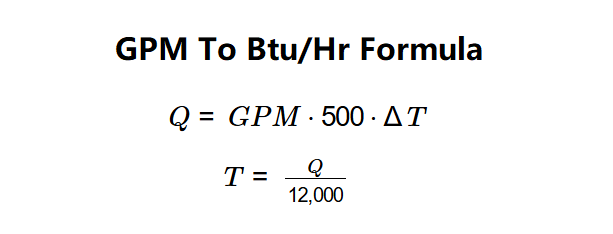1. What is GPM to BTU/hr and Ton Calculator?
Definition: This calculator computes the heat output (BTU/hr, British Thermal Units per Hour) and cooling capacity (Ton) of a water-based heating or cooling system based on the flow rate (GPM) and temperature difference (ΔT).
Purpose: It is used in HVAC, plumbing, and hydronic systems to determine heat transfer rates and cooling capacities, aiding in system design and efficiency analysis.
2. How Does the Calculator Work?
The calculator uses the following formulas:
Heat Transfer Formula:
\( Q = GPM \cdot 500 \cdot \Delta T \)
Where:
- \( Q \): Heat Output (BTU/hr)
- \( GPM \): Flow Rate (Gallons per Minute)
- \( \Delta T \): Temperature Difference (°F)
- \( 500 \): Constant (specific heat of water × weight of 1 gallon)
Cooling Capacity Formula:
\( T = \frac{Q}{12,000} \)
Where:
- \( T \): Cooling Capacity (Ton)
- \( Q \): Heat Output (BTU/hr)
- \( 12,000 \): BTU/hr per Ton
Steps:
- Enter the flow rate and temperature difference with their units (GPM/L/min, °F/°C).
- Convert inputs to base units (GPM, °F).
- Calculate the BTU/hr using the heat transfer formula.
- Calculate the Ton by dividing BTU/hr by 12,000.
- Convert the BTU/hr result to the selected output unit (BTU/h or kBTU/h).
- Display the results with 2 decimal places.
3. Importance of BTU/hr and Ton Calculation
Calculating BTU/hr and Ton is crucial for:
- System Design: Sizing boilers, chillers, or heat exchangers to match heat transfer and cooling requirements.
- Energy Efficiency: Optimizing flow rates and temperature differences to reduce energy consumption.
- Performance Analysis: Verifying that HVAC systems deliver the required heating or cooling capacity.
4. Using the Calculator
Example 1: A system with 10 GPM and a 20°F temperature difference:
- Flow Rate (\( \text{GPM} \)): 10 GPM
- Temperature Difference (\( \Delta T \)): 20°F
- BTU/hr: \( 10 \times 500 \times 20 = 100,000 \) BTU/h
- Ton: \( \frac{100,000}{12,000} \approx 8.33 \) Ton
- Result: \( Q = 100000.00 \) BTU/h (or 100.00 kBTU/h), \( T = 8.33 \) Ton
Example 2 (Celsius): A system with 37.85 L/min and a 11.11°C temperature difference:
- Flow Rate (\( \text{GPM} \)): 37.85 L/min = 10 GPM
- Temperature Difference (\( \Delta T \)): 11.11°C = 20°F
- BTU/hr: \( 10 \times 500 \times 20 = 100,000 \) BTU/h
- Ton: \( \frac{100,000}{12,000} \approx 8.33 \) Ton
- Result: \( Q = 100000.00 \) BTU/h (or 100.00 kBTU/h), \( T = 8.33 \) Ton
Example 3: A system with 5 GPM and a 15°F temperature difference:
- Flow Rate (\( \text{GPM} \)): 5 GPM
- Temperature Difference (\( \Delta T \)): 15°F
- BTU/hr: \( 5 \times 500 \times 15 = 37,500 \) BTU/h
- Ton: \( \frac{37,500}{12,000} \approx 3.13 \) Ton
- Result: \( Q = 37500.00 \) BTU/h (or 37.50 kBTU/h), \( T = 3.13 \) Ton
5. Frequently Asked Questions (FAQ)
Q: What is GPM?
A: GPM (Gallons per Minute) measures the flow rate of water in a system, critical for calculating heat transfer.
Q: Why is the constant 500 used?
A: The constant 500 is derived from the specific heat of water (1 Btu/lb/°F) and the weight of one gallon of water (8.33 lbs), adjusted for unit consistency.
Q: What is a Ton in this context?
A: A Ton of cooling capacity equals 12,000 BTU/hr, representing the heat removal rate equivalent to melting one ton of ice in 24 hours.
GPM to BTU/hr and Ton Calculator© - All Rights Reserved 2025
 Home
Home
 Back
Back
